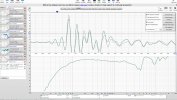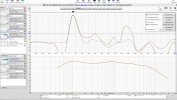For the third time. Both of your microphones are
omnidirectional. This is stated by the manufacturers of both microphones themselves.
Neither of them are ‘unidirectional’, as this would be a literal laser beam.
with this test results i come to conclusion the step response change when use EQ happen only because of phase shift EQ do..
Incorrect. Here is an example. I measured a single Faital Pro 3FE22 driver resting on it's box on my desk, with an Earthworks M30 microphone at 10 centimetres, using an 87.4 second stimulus with the AFMG EASERA TDS module. No post-processing windowing is applied.
Due to the way Time Delay Spectrometry works, we can consider this to be about as a reflection-free measurement as possible in the circumstances.
I then duplicated the trace, and edited the data directly to set the magnitude from 30 Hz to 200 Hz to a flat value at 91 dB. Markers are added to the traces to show the level increase over the original measurement.
This modification is linear phase, as you can see here in the phase trace of both data sets. The same cursors are visible, confirming identical phase at the adjusted frequencies:
Here are the two impulse responses, overlaid
You can barely see the shift in the blue modified data, so here it is zoomed in. The later part of the IR deviates more, as you'd expect from increased energy.
View attachment 175442
And here we have the two step responses. Again, blue trace is the artificially modified magnitude response with much more energy in the sub region, but no change in phase:
Bonus round - to echo what
@gnarly has said, step response is not a good way to do time alignment of sources. Again, an example. This time, a four way system, with a passive full-range speaker (blue), a low frequency speaker (green), and a subwoofer (red). I have already applied EQ, and appropriate high pass and low pass filters; all 4th order, asymmetrical electrical slopes.
Magnitude responses solo:
I have also already time-aligned each speaker, at the listening position, using delay, polarity inversions and all-pass filters based on the phase trace. This is commonly accepted practice for speaker alignment. Here are the individual pass band phase traces after alignment:
And the magnitude responses again, but this time with the sum trace of all speakers playing together in black:
Now I'm not posting these to show off. The point is that this is a pretty damn good alignment. Yet, here are the step responses for each speaker
with the alignment in place:
Zoomed in:
Just for completeness sake, the sum response with combined group delay:
Can you honestly say you'd have arrived at a similar result using just the step response? If so, what would your method be? Here's the starting point of each speaker, with the EQ (I'm not cruel...) but without any high pass or low pass filters.
The raw IR data for each passband is attached in the zip file - channel 2 contains the data. Note they're measured at 3 metres distance, and some elements are horn-loaded. You'll need to consider that when looking for the IR peak.




